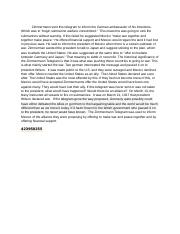

Students in grades 6-12 may work individually or in small groups, with breaks for class discussion. Included: the cracking of an encoded telegram from the German foreign minister to the president of. Zimmermann hoped tensions with Mexico would slow shipments of supplies, munitions, and troops to the Allies if the U.S. This year marks the one hundredth anniversary of the United States entry into World War I. Prepare to leave embassy on short notice. In January of 1917, British cryptographers deciphered a telegram from German Foreign Minister Arthur Zimmermann to the German Minister to Mexico, von Eckhardt, offering United States territory to Mexico in return for joining the German cause.
#Zimmermann telegram crack
FebruTo: von Eckhardt Mexico City British crack top secret code. We suggest teaching with this activity during a unit on U.S. Zimmermann sent the telegram in anticipation of resumption of unrestricted submarine warfare, an act the German government expected would likely lead to war with the U.S. The following is a fictitious telegram used in the Decoding a Message exercise that supports teaching about the Zimmermann Telegram. To conclude the activity, students will vote on whether or not the United States should have declared war on Germany based solely on the Zimmermann Telegram, explaining their pro- or anti-war rationale. The ambassador was instructed to offer the Mexican president, Venustiano Carranza, an alliance: If America entered the war, Germany proposed that Mexico open a second front against the U.S. After having remained neutral in the war for nearly three years, several events in 1916 and early 1917 occurred which brought America into the war against Germany. They will discover that in January of 1917, British codebreakers deciphered this telegram from German Foreign Minister Arthur Zimmermann to the German Minister to Mexico, offering United States territory to Mexico in return for joining the German cause. 19, 1917, Germany’s foreign minister, Arthur Zimmermann, sent a coded telegram to his ambassador in Mexico. The Zimmerman Telegram was an important piece of America's decision to enter World War One. The Zimmermann Telegram activity challenges students to examine the encoded Zimmermann Telegram and the decode worksheet, looking for clues and details about the documents that may help explain their meaning. After they discuss their findings, they will read, analyze, and summarize the decoded Zimmermann telegram-identifying its author, audience, and purpose. In a recently created learning activity on, students can analyze the Zimmermann telegram to evaluate whether, based on its information and implications, the United States should have entered World War I.īy completing the activity, they will learn that this message helped draw the United States into the war and thus changed the course of history, that: The British presented the telegram to President Woodrow Wilson, the American press published the news, and Congress declared war on Germany and its allies. The Zimmermann Telegram (or Zimmermann Memo or Zimmermann Cable) was a secret diplomatic communication issued by the German Ministry of Foreign Affairs in.


 0 kommentar(er)
0 kommentar(er)
